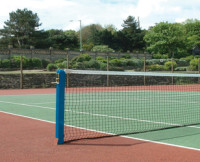
Moving through February, the forecast is for it to remain changeable, with unsettled spells interspersed with colder, showery interludes. The most unsettled and windy weather is likely to occur in the north and northwest while the south and southeast should see somewhat drier conditions overall, though even here, some rain and strong winds are likely.
If the frosty weather persists over a number of days, it could lead to a number of problems with your irrigation systems, hose pipes and outside taps. Ideally, any water carrying pipe work should be lagged or protected from frost damage, as this will lead to burst pipes and joints; make sure you keep an eye open for these leaks.
Key Tasks for February

As stated previously, if the court is frozen, keep off; you will do more harm than good.
General maintenance, dependent upon weather conditions:
- continue to cut as required, ensuring that you take no more than a third off in any one cut. Maintain a height of cut between 12-18mm
- a cylinder mower may still be used, but it is more likely that a rotary mower will serve you better
- box clippings to avoid the spread of disease
- remove leaves and other debris as soon as possible – a rotary mower does a good job
Artificial courts
Keep surface clean with regular sweeping and brushing
Remove any algae and moss from surface. Sand filled systems require regular brushing to maintain manufacturer’s recommendations on sand levels and pile heights
American Fast Dry courts
- keep surface clean, rolling to consolidate surface
- levelling and brushing of fast dry materials, brushing to clean lines
Clay courts
- carry out regular sweeping and brushing to restore levels
- topdress any hollows or damaged areas
Tarmacadam
- carry out regular sweeping and brushing
- repair any hollows or damaged areas
With many clubs allowing and, indeed encouraging, play on their artificial surfaces through the winters months (when weather conditions allow) it is imperative that these courts are completely free from moss, algae, leaves or anything else that might pose a slip hazard.




February can be a month of two halves, as the early part sees out winter and the end heralds the oncoming spring. Warmer periods of air flow coinciding with an increasingly higher and brighter sun can illicit periods of growth, particularly if night time temperatures don’t fall too far. Conversely, cold air flow, short damp days and persistent rainfall can place stress on the grass plants whilst also actively assisting fungal pathogens.
Operational windows are equally affected by the weather, and often the periods which place pressure on surfaces are the ones which also restrict a turf manager’s ability to undertake preventative or curative maintenance.
Management of soils is a prime function of managing turf grass. No more important factor is the successful management of water. Too little and the soil food web, of which grass plants play a part, breaks down. At this time of the year, the problem tends to be too much water, leading to saturation which again breaks the balance of the soil food web as microorganisms essentially drown.
In this instance, keeping abreast of weather forecasts so that you are prepared to strike when ground or wind conditions are favourable for maintenance means you can act quickly.
In regards to soil water management, vertical deep tine aeration undertaken in the autumn will still be facilitating passage of water through the soil and hopefully into drainage systems. Maintaining a passage for water away from the surface is vital in allowing deeper fissures and tine holes to draw water. As a result, taking any opportunity to aerate with pencil, slit, star or sarel tines is an important priority.
The use of wetting agents in conjunction with good old fashioned aeration should also be considered at this time of the year. A penetrant type will break water tension allowing it to flow from the surface more efficiently. Conversely a high quality block co-polymer, sometimes referred to as a residual, will help to regulate the balance of water in the soil, by holding onto or releasing water through the profile. The ideal ratio being 50% solid, 25% water, 25% air.
Similar to fertilisers programmes, it is advisable to implement a wetting agent programme which formulates your surfactant applications thought the year. The high quality block co-polymer chemistry works as a preventative in the soil, actively balancing the soil water matrix as it builds up over time. Single applications will not be successful in overcoming evidence of hydrophobic soils as evidence by dry patch. Like many things, once you see the symptoms, it is indicating you should have acted much earlier to prevent them appearing. Block co-polymers take 3-4 months to build up in a soil to a point where the chemistry is working optimally. For this reason, in the UK applications, should start no later than March with frequencies as recommended by the manufacturer to avoid a drop-off in soil concentration, and thus positive effects.
Somewhat erroneously, wetting agents have had a bad reputation in certain quarters in respects to negative effects upon soil biology. Such perception should be reserved for curative wetting agents which, by necessity of their action, are designed to strip away the organic acids coated around soil particles. Being designed to work preventatively, block co-polymer wetting agents are not formulated in ways which have these effects. Research has even shown that they can have a beneficial effect on soil biology leading to increased fertiliser efficiency, improved fungicide effect, better drought tolerance when used with trinexapac-ethly, and reduced incidence of anthracnose disease.
The aim of high quality preventative block co-polymer wetting agents is to facilitate even distribution of water throughout the soil profile. Where this is not taking place, a lack of uniformity can facilitate ‘finger flow’, which is to say isolated preferential paths for water to move throughout the profile. During months such as February, this will not cause a problem on the surface as the baseline for soil moisture is so high. Once the summer months come around however, the spaces between these preferential paths will be the first to dry out and show up as dry patch.
Penetrant wetting agents can be used to break surface tension and aid the flow of water from the surface and through the soil; whether that be aeration holes or a freshly applied hydrophobic top dressing. Testing your top dressing for hydrophobicity by dripping droplets of water onto a sample is a prudent exercise. Anything more than 5 seconds to soak in signifies some level of hydrophobicity.
Nutrition requirement may pick up as the month progresses. Where the forecast is for cold and harsh or warm and damp, foliar applications of calcium and silicon will help the plant to stand up to the resultant biotic and abiotic stresses. Chelated iron should always be the option when attempting to elicit a green up, however the end of February or early March is the best time to apply iron sulphate. Aside from the green up, it will help to knock back moss which may have encroached over the winter and the sulphur will help to facilitate early season plant metabolic function.
Warm, damp, still days are perfect conditions for microdochium nivale activity. When temperatures are cold then make the most of those last applications of iprodione before the withdrawal from sales on 5th March 2018 and withdrawal from use of stocks on 5th June 2018
As soils warm, chafer grubs and leather jackets will begin to rise and pecking of surfaces may well begin. There are no treatments for the grubs at this time of the year, but monitoring and recording problematic areas in anticipation of nematode treatments in the summer is a key part of any integrated management plan.
Finally, take the guess work out of fertiliser programmes by investing a few pounds in a broad spectrum soil analysis. Remember, no one nutrient is more important than the other; it is only the quantity of each which the plant requires for health which varies. Obtaining a report now gives you a guideline and insight, both of which allow you to address deficiencies and balance out ratios through the oncoming season such that your turf surfaces are at their best.
With some machines not currently being used, take the time to carry out an overhaul or send them away for a service.
- inspect and clean machinery before putting away for the winter
- replace worn and damaged parts as necessary
- empty fuel tanks as petrol will go stale over winter
- maintain a stock of consumables for your machinery
- secure machinery nightly with good storage facilities and strong locks
- record makes and models and take pictures of your equipment as additional reference
- don’t leave it to the last minute when servicing dealers will be very busy

Some of the other courses available are:
- Chainsaws - CS30 and CS31
- H&S Refresher Training on Combined Turf Care Equipment; Tractors and Trailers; All Mowers (Ride-on and Pedestrian)
- Machinery Courses on ATVs; Tractors: Brushcutters/Strimmers; Mowers (ride-on and Pedestrian)
- Pesticide Application (PA courses)
- Stem Injection of Invasive Species (Japanese Knotweed etc.)
- Basic Trees Survey and Inspection
More details about all the courses can be found on our new Grounds Training website, or you can email Chris Johnson for information.
- repair and maintain fence lines
- cut back any hedges and trees and prune shrubs
- take down and store all tennis equipment, ensuring that it is clean and dry before doing so
- repair/update equipment as necessary
Whilst many of the above actions may appear to be common sense, it is surprising how some things can get overlooked, often due to the lack of daylight hours. The more that club members, players and officials understand what you role involves, the better. You could use any spare time to provide a members newsletter/blog detailing what problems you are experiencing (disease outbreaks, algae and moss, waterlogging etc.) and to seek additional help as required


